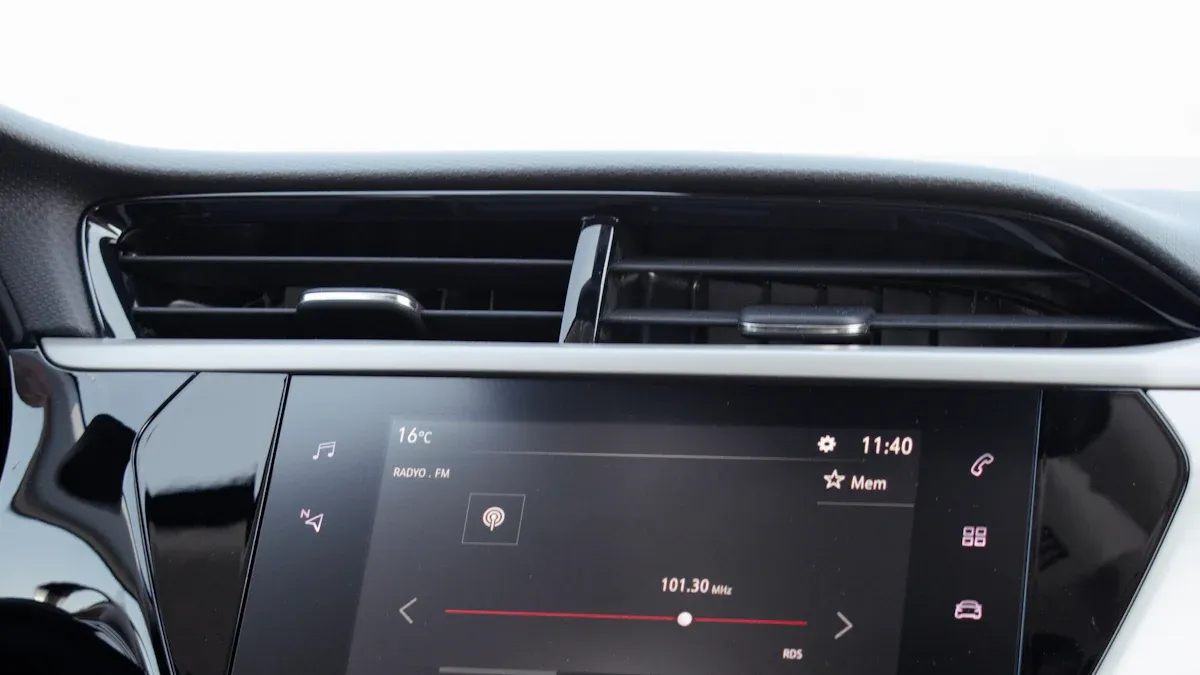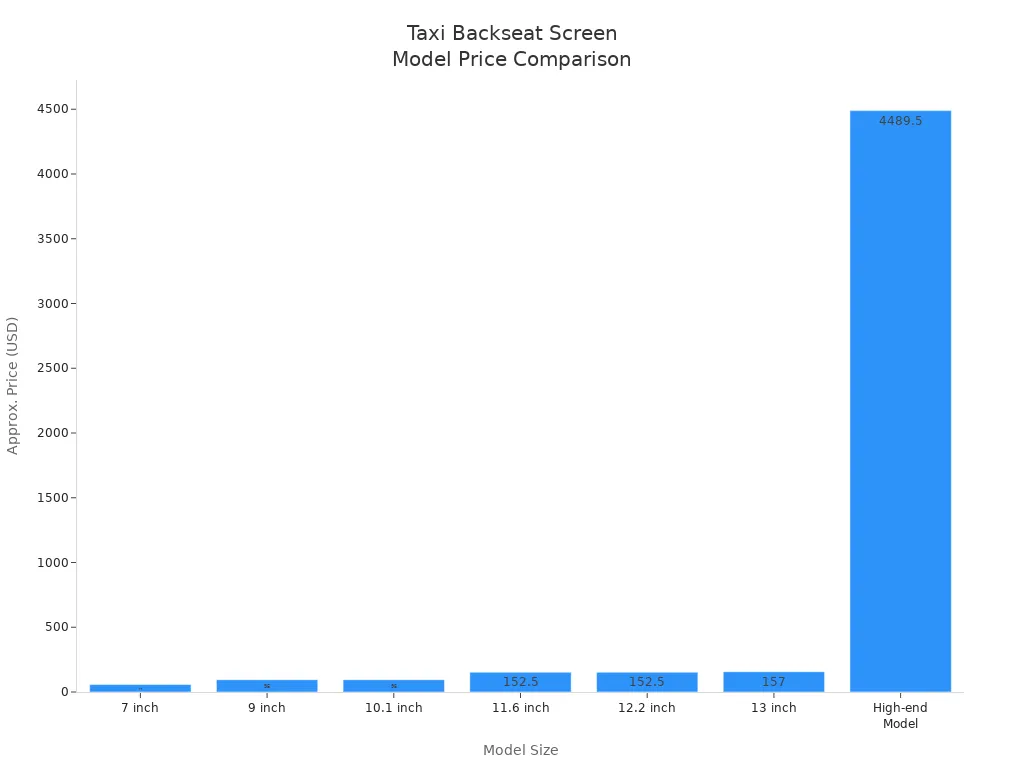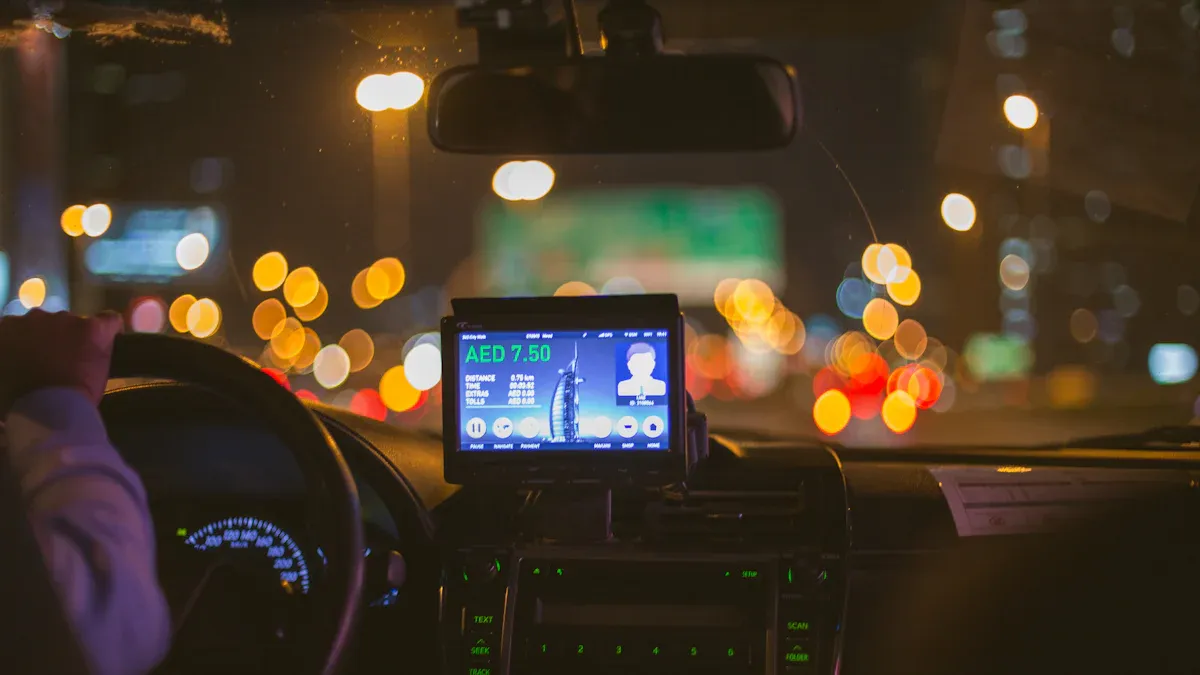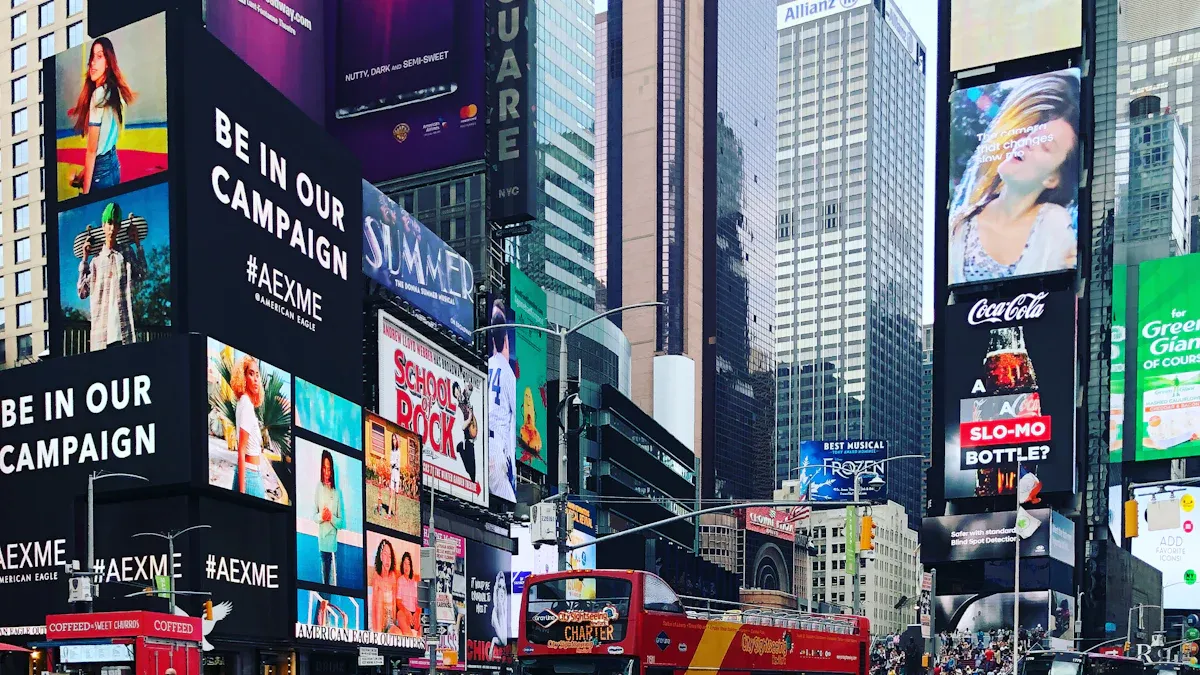
Taxi backseat screen technology has changed ads in cars. The best models have clear screens and touch controls. They also connect to the internet very well. Many screens use Android OS and have Wi-Fi. Some have 4G or 5G for updates from far away. These things help advertisers reach more people. They also make passengers pay more attention.
Display Type | Resolution | Connectivity | Key Features | Approx. Price (USD) | |
|---|---|---|---|---|---|
10.1 | Android Headrest Monitor | 1280×800 HD | 3G/4G, Wi-Fi, HDMI, USB | Capacitive Touchscreen, Ambient Light Control, Remote Management | $60 – $130 |
11.6 | IPS Android Headrest Monitor | Full HD (1920×1080) | 4G, Wi-Fi, USB | Front Camera, Touchscreen, Content Scheduling | $137 – $168 |
12.2 | LCD IPS Android Headrest Monitor | 1920×1200 HD | Wi-Fi, 4G, GPS | Capacitive Touchscreen, Android 11 OS, Multimedia Playback | $145 – $160 |

Key Takeaways
Taxi backseat screens have bright displays and touch buttons. They show fun ads that get passengers to look during rides. These screens use Wi-Fi or 4G/5G to go online. This lets advertisers change ads fast and aim them at certain places. Passengers can join in with polls, quizzes, and QR codes. This makes ads easier to remember and work better. Advertisers should pick screens that match their goals and budget. They should also think about their business type for the best results. Good screens last long and are easy to use. This helps taxi companies and advertisers reach more people and make ads work better.
Top Taxi Backseat Screen Picks

Leading Models Overview
Many big cities use special screens for ads in taxis. NSE Taxi LED Displays are a popular pick. These screens have sharp, double-sided LED panels. They sit on top of taxis. They have features like geo-targeting and cloud management. The screens can handle bad weather. Models like TS-2018 and TS-2022 show HD videos. They use smart controllers with GPS. Advertisers can send ads to certain places. This helps them reach more people.
E-NetCanvas.com is also a leader with its backseat touchscreen system. This system attaches to plexiglass shields. It is strong and hard to break. Cities like New York, London, Tokyo, and Dubai use this system. Almost 30 million units are in use around the world. Passengers see safety tips, trip info, and local ads. These ads cannot be skipped. This gives advertisers lots of views.
Linsnled.com shows how flexible car LED screens are. These screens can go on back windows, rooftops, or behind seats. They are bright and work well in cities. Taxi backseat screens from these brands help advertisers reach riders and people outside.
What Sets Them Apart
Android-based systems make it easy to manage ads.
Touch screens let passengers interact with ads.
Each model fits well in taxis to get more attention.
LCD technology keeps pictures clear while driving.
Designs help ads reach more people inside taxis.
Note: The best taxi backseat screens use smart tech and easy features. This helps brands talk to people in busy cities.
Taxi Advertising Impact

Audience Engagement
Taxi backseat screens help people pay more attention to ads. Passengers sit in taxis for a few minutes. This gives them time to see and use the ads. The screens show pictures and play sounds. This makes ads easier to remember than posters. Many screens let people take polls or play quizzes. Some have contests too. Passengers can touch the screen to answer or join social media. This makes them focus more and remember the ads.
Passengers cannot leave, so they see the ads longer.
Fun content makes people want to join in.
Ads change based on where the taxi is, so they matter more.
Advertisers get quick feedback and can change ads fast.
Taxi ads turn a ride into a fun brand moment. Riders remember these ads and may do what the ad says.
Benefits Over Traditional Ads
Taxi ads have more good points than old types of ads. Billboards and radio play when people are busy. Taxi screens show ads when riders pay attention. The time and place make the ads work better. Advertisers can change ads right away with Wi-Fi or 4G/5G. This lets them make new ads for news or local events.
Taxi screens use video, sound, and touch, not just pictures.
Advertisers can pick certain places or events for their ads.
Data helps show how people watch and use the ads.
Taxi ads help taxi owners make more money from ads. They can see how many people watch and act on the ads. This helps brands see the value. More companies use taxi ads to reach city people in a clear way.
Review Criteria
Experts and advertisers use some main rules to judge taxi backseat screens. These rules make sure screens work well for ads and give passengers a good time.
Screen resolution and display quality
Touch functionality and interactivity
Android OS and software usability
Wi-Fi, 4G, or 5G connectivity
Analytics and campaign tracking
Durability and reliability
Supplier support and installation needs
People look at reviews, tech details, and what advertisers want. These rules help brands pick screens that get riders’ attention and make ads work better.
Display Quality
A bright LCD screen with high resolution gets people to look. The screen must show moving pictures and videos. This makes ads look nice and easy to see in any light. Good screens help brands get noticed and keep riders watching.
Interactivity
Touchscreens, quizzes, and QR codes make ads more fun. Riders can join polls or get coupons. This helps ads work better. Special offers based on the trip make the ride better and help advertisers get more value.
Connectivity
Taxi screens use Wi-Fi, LAN, and 4G to connect. These let advertisers change ads from far away and set times for them. GPS helps show ads that match where the taxi is. Riders see ads that fit their trip and spot.
Analytics
Analytics tools count how often ads show and who sees them. GPS and tracking give advertisers important info. Feedback in apps shows how ads do and how riders react. These tools help brands make ads better and see if they work.
Reliability
Strong screens last through daily taxi rides. Good hardware and easy software stop problems and make people happy. Help from suppliers and simple setup are important too. A good system keeps ads showing and makes drivers and riders trust it.
Taxi Backseat Screen Reviews
Model 1: High-Res Android LCD
The High-Res Android LCD has a very clear screen. The colors look bright and the pictures are sharp. Riders like how easy it is to use. This screen lets people watch shows from their phones or tablets. Passengers have more ways to have fun on their ride.
Aspect | Details |
|---|---|
Key Features | High-resolution screen, user-friendly interface, wireless streaming, multiple connectivity options |
Pros | Immersive viewing, personalized entertainment, intuitive controls |
Cons | Compatibility issues with some vehicles, installation challenges, some durability concerns |
User Feedback | Users like the display but mention installation and durability as main issues |
Notes | Important to check screen size, resolution, and connectivity before buying |
This model is good for taxi fleets that want nice screens. It is best for showing cool videos and letting riders touch the screen. Companies should think about what cars they have before buying.
Model 2: Touchscreen Wi-Fi Display
The Touchscreen Wi-Fi Display lets riders touch the screen and use many apps. It has a 4K LG LED screen that is bright and easy to see. Ads and videos look good even when it is sunny. The screen works fast and plays lots of media types. It can play videos over and over to keep people watching.
Feature Category | Details |
|---|---|
Display | 4K LG LED, 3840×2160, 350 cd/m² brightness, 178° viewing angle |
Processor & OS | Intel Core i5, 8GB RAM, 128GB SSD, Windows 11 Pro |
Interactivity | Responsive touchscreen, supports various media, automatic looping |
Connectivity | HDMI, USB, Intel Wi-Fi Link 5100, RJ45 Ethernet, Wi-Fi 6, Bluetooth |
Audio-Visual | Built-in speakers for clear sound |
Durability & Design | Sturdy build, IP65 water and dust resistance, POE and DC power options |
Management | Remote device management, kiosk lockdown apps |
Advertisers can change ads from far away and keep the screen safe. This screen is great for busy city taxis that want to show fun ads.
Model 3: Affordable Quad-Core Option
The Affordable Quad-Core Option is good for taxi owners who want to save money. It uses a Q6600 processor, which was a big deal for its time. This screen can handle videos and pictures well. It is not as good at saving power as newer models.
Aspect | Feedback Summary |
|---|---|
Performance | Good for multitasking and editing, but less efficient than dual-core alternatives |
Application Use | Best for video/image editing, less advantage in basic tasks |
Power Efficiency | Uses more power than dual-core models |
Pricing | Became more affordable over time, but still higher than some dual-core options |
Durability Feedback | No direct feedback on durability from advertisers |
Overall Impression | Important milestone for quad-core, but dual-core may suit most current needs |
This model is best for taxis that only need simple ads. It is a smart pick for companies that do not want to spend a lot.
Model 4: DOOH Network-Ready Screen
The DOOH Network-Ready Screen connects to big ad networks. Marketers can buy ad space fast and change ads right away. They can pick who sees the ads by where they are or what they like.
This screen lets people update ads from far away. Marketers can check how many people see the ads and make changes. It is great for big taxi fleets that want to join worldwide ad networks. With tools like geofencing and heatmaps, ads reach the right people at the right time.
Note: The DOOH Network-Ready Screen helps brands run ads in many taxis and places. It is a top pick for companies that want to reach lots of people and target ads well.
Comparison Table
Features Side-by-Side
Model Name | Display Type | Resolution | Interactivity | Connectivity | Analytics | Durability | Price Range |
|---|---|---|---|---|---|---|---|
High-Res Android LCD | LCD | 1280×800 HD | Touchscreen | Wi-Fi, 3G/4G, HDMI | Yes | Moderate | $60-$130 |
Touchscreen Wi-Fi Display | LED | 4K (3840×2160) | Touchscreen | Wi-Fi 6, Ethernet | Yes | High | $137-$168 |
Affordable Quad-Core Option | LCD | 1920×1200 HD | Basic | Wi-Fi, 4G, GPS | Limited | Moderate | $145-$160 |
DOOH Network-Ready Screen | LED | Full HD | Touchscreen | Wi-Fi, 4G, GPS | Advanced | High | Varies |
Note: Every model has its own mix of display, connection, and touch features. Taxi companies can pick what fits their ad needs best.
Strengths and Weaknesses
LCD taxi backseat screens are known for clear pictures and touch features. Advertisers can change ads fast and show them in the right places. Brands use these screens to make riders notice and remember ads. The touch design helps people join in and act on ads. But, companies must fix screens often and follow city rules to keep ads working well.
LED screens are great because they are bright and easy to see. They work day and night, so ads show to riders and people outside. These screens can play ads all day and reach many parts of the city. LED models are good for brands that want to show ads everywhere and change them quickly. Still, advertisers must plan what to show and work with drivers to keep everyone safe.
LCD Strengths: Gets riders involved, updates ads fast, focuses on passengers.
LCD Weaknesses: Needs fixing often, must follow rules.
LED Strengths: Shows ads to lots of people, looks bright, can change times.
LED Weaknesses: Must plan what to show, needs safe teamwork.
Taxi companies and advertisers should pick a screen that matches their goals. LCDs are best for getting riders to join in. LED screens are better for showing ads to lots of people in the city. Good planning helps each screen work its best.
Choosing the Right Taxi Screen
Matching Features to Goals
Advertisers need to know their goals before starting. Some want more people to know their brand. Others want new customers or to share news about events. Taxi backseat screens help show ads to people who cannot leave. These screens play videos and moving ads. Most taxi riders are young and have money. Ads that interest this group work best. But, it is hard to target ads because there is not much rider data. Advertisers can use QR codes or promo codes to see who responds. They should also follow local laws to keep ads safe and right.
Tip: Pick screens that play good videos and let people touch them. This helps get more attention during the ride.
Business Type Considerations
The kind of business changes which taxi screen is best. Local shops can use screens to tell riders about stores or events nearby. This helps them talk to people in their city. Big brands can use screens to share messages with lots of people. Some screens, like the Sepine rear LCD, let advertisers change ads for different riders. This makes more people notice and remember the brand. Changing ads from far away helps companies run new campaigns fast.
Local businesses: Show ads for things close to the taxi.
National brands: Share big messages for everyone.
Both: Get more from riders who must see the screens.
Budget and ROI
Money matters when picking a taxi screen. Fancy screens with more features cost more. But they can help make more money from ads. Advertisers should look at the price and what they might earn back. Tools like digital tracking and promo codes help check if ads work. By showing ads to the right people, companies can earn more and use their money well.
Note: The right taxi screen can make every ride a good chance to show ads.
The best taxi backseat screens have clear displays and touch controls. They connect to the internet easily. Each screen helps with different ad needs. Some are good for getting riders to join in. Others help show ads to lots of people in the city. Companies should pick screens that fit their goals and how much they want to spend. Adhaiwell gives helpful guides and market info. This helps businesses see why taxi digital signage is useful. Their custom options and advice help companies use screens well and reach more people with ads.
FAQ
What makes a taxi backseat screen effective for advertising?
A taxi backseat screen works best if it is bright. It should have touch features and connect to the internet well. These things help ads look clear. Passengers can also touch the screen and join in.
How do advertisers update content on taxi screens?
Advertisers use special tools to change ads from far away. They send new ads using Wi-Fi or 4G/5G. This keeps the ads new and interesting for riders.
Are taxi backseat screens secure for user data?
Most new screens use safe software and locked connections. These steps keep passenger data and advertiser info safe from hackers.
Can small businesses benefit from taxi screen ads?
Yes. Small businesses can show ads to people near their stores. Taxis drive in local areas, so more people nearby see the ads. This helps more people know about the business.
How do taxi screens measure ad performance?
Taxi screens count how many people see and use the ads. Advertisers get reports with numbers for views, clicks, and actions. This helps them make better ads next time.
See Also
Best Wireless CarPlay Devices For Effortless Driving Experience
Budget-Friendly Portable CarPlay Solutions Suitable For All Drivers
Best CarPlay Adapters Compatible With 2023 Ford F-150 Models
Leading Ten Wireless CarPlay Devices For Smooth Driving Experience
Best Ten Wireless CarPlay Adapters Designed For 2025 Fiat Cars
